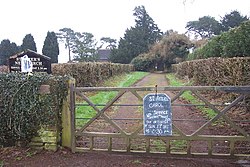Newchurch, Monmouthshire: Difference between revisions
No edit summary |
|||
| (One intermediate revision by the same user not shown) | |||
| Line 10: | Line 10: | ||
|postcode=NP16 | |postcode=NP16 | ||
|dialling code=01291 | |dialling code=01291 | ||
|population= | |population=674 | ||
|census year= | |census year= | ||
|LG district=Monmouthshire | |LG district=Monmouthshire | ||
|constituency=Monmouth | |constituency=Monmouth | ||
}} | }} | ||
'''Newchurch''' is an extensive rural parish and small hamlet in [[Monmouthshire]]. It is located six miles south east of [[Usk]] and six miles north west of [[Chepstow]], between the B4235 and B4293 roads. | '''Newchurch''' is an extensive rural parish and small hamlet in [[Monmouthshire]]. It is located six miles south-east of [[Usk]] and six miles north-west of [[Chepstow]], between the B4235 and B4293 roads. | ||
== History and amenities== | == History and amenities== | ||
| Line 22: | Line 22: | ||
In the early 12th century the Newchurch area was known as Plataland and was given by the Marcher lord of Striguil, or [[Chepstow]], to [[Tintern Abbey]]. The monks cleared much of the land for farming, but in 1302 exchanged it with Roger Bigod, Earl of Norfolk, for land at [[Woolaston]] in what is now [[Gloucestershire]].<ref>[http://cistercian-way.newport.ac.uk/place.asp?PlaceID=368 The Cistercian Way]</ref> The parish still contains much of Wentwood and also, to the east, Chepstow Park Wood south of [[Devauden]]. | In the early 12th century the Newchurch area was known as Plataland and was given by the Marcher lord of Striguil, or [[Chepstow]], to [[Tintern Abbey]]. The monks cleared much of the land for farming, but in 1302 exchanged it with Roger Bigod, Earl of Norfolk, for land at [[Woolaston]] in what is now [[Gloucestershire]].<ref>[http://cistercian-way.newport.ac.uk/place.asp?PlaceID=368 The Cistercian Way]</ref> The parish still contains much of Wentwood and also, to the east, Chepstow Park Wood south of [[Devauden]]. | ||
Bigod built a church for the tenants of his land, which became known as Newchurch. The parish church is dedicated to St | Bigod built a church for the tenants of his land, which became known as Newchurch. The parish church is dedicated to St Peter. It has some 14th-century features but was largely rebuilt around 1865.<ref name=newman>John Newman, ''The Buildings of Wales: Gwent/Monmouthshire'', 2000, ISBN 0-14-071053-1</ref> | ||
The modern hamlet consists of little more than the church, three houses and a farm. | The modern hamlet consists of little more than the church, three houses and a farm. | ||
===Cas Troggy=== | ===Cas Troggy=== | ||
Cas Troggy is a small ruined fortified hunting lodge or manor house built by Roger Bigod around 1303. It is located within Newchurch parish, beside the Troggy (or Castrogi) Brook and the old road between Chepstow and Usk, on the northern slopes of Wentwood at Pen y cae-mawr. It was probably abandoned shortly after Bigod's death in 1306.<ref>[http://www.gatehouse-gazetteer.info/Welshsites/544.html Cas Troggy at The Gatehouse]</ref><ref>[http://www.castlewales.com/troggy.html Castell Troggy at CastleWales]</ref> The 16th century antiquarian William Camden incorrectly referred to the ruins as Striguil, a mistake repeated on some later maps. | Cas Troggy is a small ruined fortified hunting lodge or manor house built by Roger Bigod around 1303. It is located within Newchurch parish, beside the Troggy (or Castrogi) Brook and the old road between Chepstow and Usk, on the northern slopes of Wentwood at [[Pen y cae-mawr]]. It was probably abandoned shortly after Bigod's death in 1306.<ref>[http://www.gatehouse-gazetteer.info/Welshsites/544.html Cas Troggy at The Gatehouse]</ref><ref>[http://www.castlewales.com/troggy.html Castell Troggy at CastleWales]</ref> The 16th century antiquarian William Camden incorrectly referred to the ruins as Striguil, a mistake repeated on some later maps. | ||
==References== | ==References== | ||
Latest revision as of 14:59, 26 February 2016
| Newchurch | |
| Monmouthshire | |
|---|---|
 St Peter's Newchurch | |
| Location | |
| Grid reference: | ST454976 |
| Location: | 51°40’29"N, 2°47’22"W |
| Data | |
| Population: | 674 |
| Post town: | Chepstow |
| Postcode: | NP16 |
| Dialling code: | 01291 |
| Local Government | |
| Council: | Monmouthshire |
| Parliamentary constituency: |
Monmouth |
Newchurch is an extensive rural parish and small hamlet in Monmouthshire. It is located six miles south-east of Usk and six miles north-west of Chepstow, between the B4235 and B4293 roads.
History and amenities
Before the Norman conquest the area was heavily forested as part of Wentwood. There is a Neolithic dolmen or burial chamber at Gaer-llwyd, one mile south west of the village close to the B4235.
In the early 12th century the Newchurch area was known as Plataland and was given by the Marcher lord of Striguil, or Chepstow, to Tintern Abbey. The monks cleared much of the land for farming, but in 1302 exchanged it with Roger Bigod, Earl of Norfolk, for land at Woolaston in what is now Gloucestershire.[1] The parish still contains much of Wentwood and also, to the east, Chepstow Park Wood south of Devauden.
Bigod built a church for the tenants of his land, which became known as Newchurch. The parish church is dedicated to St Peter. It has some 14th-century features but was largely rebuilt around 1865.[2]
The modern hamlet consists of little more than the church, three houses and a farm.
Cas Troggy
Cas Troggy is a small ruined fortified hunting lodge or manor house built by Roger Bigod around 1303. It is located within Newchurch parish, beside the Troggy (or Castrogi) Brook and the old road between Chepstow and Usk, on the northern slopes of Wentwood at Pen y cae-mawr. It was probably abandoned shortly after Bigod's death in 1306.[3][4] The 16th century antiquarian William Camden incorrectly referred to the ruins as Striguil, a mistake repeated on some later maps.
References
- ↑ The Cistercian Way
- ↑ John Newman, The Buildings of Wales: Gwent/Monmouthshire, 2000, ISBN 0-14-071053-1
- ↑ Cas Troggy at The Gatehouse
- ↑ Castell Troggy at CastleWales